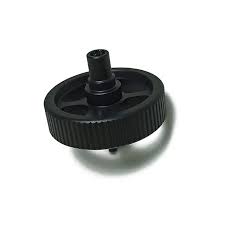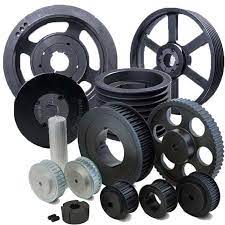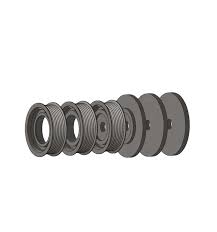Product Description
Hardware Auto Spare Part Bearing Coil winding Plastic Ceramic Wire Xihu (West Lake) Dis. Pulley for cable
Description:
1. In the wire and cable industry, ceramics has become the material of choice and convenience. Almost all facets of wire and cable manufacture have benefited by the use of ceramics in the production processes.
2…Pulley flanges, CNC Machined and available in fully anodized Aluminum, coated with anti corrosion layers, are not affected by most wire drawing solutions and do not need frequent maintenance vis-à -vis Phenolic materials.
Feature:
1. Flanged ceramic roller, Wire guide pulleys (ceramic pulleys) is commonly used component when wire passing is required, it can be used in coil winding machine, cable machine and the textile machinery as well.
2. The porcelain ring is mounted on the bearing, Coil winding wire guide pulley(wire roller) will rotate by the thread and wire passing on the surface of the ring. Thus the sliding friction has been converted to the static friction.
3. The surface Polish degree of the porcelain ring reaches Ra0.2;
4. The beating during rotation is under 0.15. We select the 99% AL2O3 as the material with the hardness of HRA88 and the density of 3.85…
5. Two nylon side walls have been put to the both side of the ceramic ring and the bearing, coil winding wire guide pulley (wire roller) combines 1 wire roller.
Service:
1. With many available designs and configurations, such as bolt together, CHINAMFG ceramic, or coated aluminum. CHINAMFG can satisfy the unique requirements of the wire and cable industry.
2. HARTAI’s AL95 guide pulleys are long lasting, will help improve wire surface quality and at the same time reduce maintenance and production costs.
3. CHINAMFG offers dozens standard sizes of guide pulleys. A large inventory of pulleys is maintained for the most widely used sizes for immediate delivery. Xihu (West Lake) Dis. pulleys can also be manufactured to specific requirements and detail.
Specifications of wire guide pulley ( ± 0.5mm)
| Model | A | B | C | D | E |
| HCR001-B03 | 20 | 15 | 3 | 4.8 | 3 |
| HCR002-B03 | 28.7 | 20 | 3 | 6.4 | 4 |
| HCR002-B04 | 28.7 | 20 | 4 | 6.4 | 4 |
| HCR002-B05 | 28.7 | 20 | 5 | 6.4 | 4 |
| HCR003-B03 | 30.4 | 15 | 3 | 10 | 3 |
| HCR004-B04 | 40 | 20 | 4 | 15 | 3 |
| HCR004-B05 | 40 | 20 | 5 | 15 | 3 |
| HCR004-B07 | 40 | 20 | 7 | 15 | 3 |
| HCR045-B05 | 45 | 30 | 5 | 10 | 6 |
| HCR045-B06 | 45 | 30 | 6 | 10 | 6 |
| HCR045-B07 | 45 | 30 | 7 | 10 | 6 |
| HCR045-B08 | 45 | 30 | 8 | 10 | 6 |
| HCR005-B05 | 55 | 30 | 5 | 10 | 6 |
| HCR005-B06 | 55 | 30 | 6 | 10 | 6 |
| HCR005-B07 | 55 | 30 | 7 | 10 | 6 |
| HCR005-B08 | 55 | 30 | 8 | 10 | 6 |
| HCR006-B07 | 60 | 40 | 7 | 13 | 6 |
| HCR006-B08 | 60 | 40 | 8 | 13 | 6 |
| HCR006-B571 | 60 | 40 | 10 | 13 | 6 |
| HCR006-B012 | 60 | 40 | 12 | 13 | 6 |
| HCR007-B05 | 60 | 30 | 5 | 18 | 6 |
| HCR007-B06 | 60 | 30 | 6 | 18 | 6 |
| HCR007-B07 | 60 | 30 | 7 | 18 | 6 |
| HCR007-B08 | 60 | 30 | 8 | 18 | 6 |
| HCR008-B10 | 80 | 50 | 10 | 15 | 9 |
| HCR008-B12 | 80 | 50 | 12 | 15 | 9 |
| HCR009-B07 | 80 | 40 | 7 | 25 | 6 |
| HCR009-B08 | 80 | 40 | 8 | 25 | 6 |
| HCR571 | 100 | 50 | 10 | 30 | 9 |
Company profile
HARTAI TECHNOLOGYLIMITED was founded in 2001, the factory is located in HangZhou city. ZheJiang province.
We specialized in the manufacture and RD of the component which is used in coil of wire and tension systems. textile machinery and electrical industry precision ceramics. Such as: coil winding nozzle, coil winding tensioner, tension meter, ceramic eyelets, ceramic coating pulley. etc.
We produce high quality coil winding nozzle which include tungsten carbide nozzle, ruby nozzle and ceramic nozzle. We adopt the excellent raw material and technology to ensure best quality which exceed our customer’s expection. Our main customer Mitsubishi, ABB, SVM, YKK. etc, We expect long term relationship with you!
Our Factory Advantages:
1. Competitive prices
2. Good after-sale services
3. Fast delivery
4. High quality control
5. Customized size, design
Other products
We also provide other relative precision parts
For more product, pls see the photos as follow, if you need, pls contact us.
FAQ
Frequently Asked Question:
Q1. How long will I get a quotation?
The quotation will send to you within the 24h when we got your inquiry.
Q2. Can I get a sample?
Samples are available CHINAMFG customers request .
Q3. Can you do the design for us?
Yes, our factory can accept the OEM orders.
According to your drawing or sample to do it.
Q4. How long can I expect to get the sample and mass quantities?
Normally it takes 7 working days to produce the sample. Generally, 7-15 working days for mass order. If urgent ,delivery time may be pushed by negotiation.
Q5. How about the delivery method?
The goods always sent by DHL,UPS,FEDEX, EMS by airplane or sea.
We also can send the goods to your warehouse if you have warehouse in China.
Q6.What’s your terms of payment?
T/T ,30%deposit, 30%balance. Other payment methods such as Paypal, West Union, L/C are negotiable.
Q7.What’s your main product?
Our company main products including various nozzle,coil of wire,tensioner etc.
Q8.What’s the application of your products?
Various products have been widely used in various type of electronics,machinery,textile and other equipment.
Contact us
Welcome to send the inquiry to us to get more details information.
/* January 22, 2571 19:08:37 */!function(){function s(e,r){var a,o={};try{e&&e.split(“,”).forEach(function(e,t){e&&(a=e.match(/(.*?):(.*)$/))&&1
| Classification: | Special Parts |
|---|---|
| Processing Type: | Mechanical Process |
| Match Machine: | Spinning Equipment |
| Material: | Plastic and Ceramic |
| Processing Level: | Precision Finishing |
| Mechanical Process: | Grinding |
| Samples: |
US$ 3/Piece
1 Piece(Min.Order) | |
|---|
| Customization: |
Available
| Customized Request |
|---|

What maintenance procedures are necessary to ensure the reliability of spinning pulleys?
To ensure the reliability of spinning pulleys, certain maintenance procedures should be followed. These procedures help identify and address potential issues, prevent premature wear, and extend the lifespan of the pulleys. Here are some essential maintenance procedures:
1. Regular Inspection:
Periodic visual inspections of spinning pulleys are necessary to identify any signs of wear, damage, misalignment, or abnormal operating conditions. Inspections can help detect issues such as worn grooves, cracks, excessive belt wear, loose fasteners, or inadequate lubrication.
2. Lubrication:
Proper lubrication is crucial for the smooth operation of spinning pulleys. Lubricants reduce friction between the pulley and the belt, rope, or cable, minimizing wear and heat generation. The type and frequency of lubrication depend on the specific application and the manufacturer’s recommendations.
3. Belt Tension Adjustment:
Maintaining proper belt tension is important to prevent slippage and ensure efficient power transmission. Regularly checking and adjusting the belt tension according to the manufacturer’s guidelines or industry standards is essential. Improper tension can lead to reduced power transfer, accelerated wear, and decreased overall system performance.
4. Belt Cleaning:
Contaminants such as dust, dirt, or debris can accumulate on the pulley and the belt, affecting their performance. Regular cleaning of the pulleys and the belts with appropriate methods, such as brushing or compressed air, helps remove these contaminants and prevents their buildup.
5. Alignment Checks:
Spinning pulleys should be properly aligned to ensure smooth and efficient power transmission. Misalignment can cause increased stress on the pulleys, belts, and other power transmission components, leading to premature wear and potential system failures. Regular alignment checks using alignment tools or laser alignment systems help identify and correct misalignment issues.
6. Balancing:
Imbalanced spinning pulleys can result in vibration, which can adversely affect the overall system performance and lead to premature wear or failure of the pulleys and other components. Balancing procedures, such as adding balance weights or utilizing dynamic balancing equipment, can help minimize vibration and ensure smooth operation.
7. Repair or Replacement:
If any significant damage or wear is detected during inspections or maintenance procedures, appropriate repair or replacement actions should be taken promptly. This may involve repairing damaged pulley surfaces, replacing worn-out belts, or replacing the entire pulley if necessary.
8. Documentation and Record-Keeping:
Maintaining comprehensive records of maintenance activities, including inspection dates, lubrication schedules, adjustments, repairs, and replacements, is essential. These records help track the maintenance history of spinning pulleys, identify patterns or recurring issues, and facilitate proactive maintenance planning.
By following these maintenance procedures, the reliability and performance of spinning pulleys can be maximized, ensuring their optimal operation and contributing to the overall efficiency and longevity of the machinery or equipment they are a part of.

What are some real-world examples of spinning pulley applications in various industries?
Spinning pulleys find widespread applications in various industries, contributing to the smooth operation of different machines and systems. Here are some real-world examples of spinning pulley applications in various industries:
1. Manufacturing and Industrial Machinery:
– Conveyor Systems: Spinning pulleys are extensively used in conveyor systems across industries such as manufacturing, logistics, and mining. They help drive and guide conveyor belts, enabling the efficient movement of materials or products.
– Printing Presses: In the printing industry, spinning pulleys are crucial components in printing presses. They facilitate the movement of paper or printing substrates, ensuring precise registration and consistent printing quality.
– Machine Tools: Spinning pulleys are found in various machine tools like lathes, milling machines, and drill presses. They enable speed control and power transmission, allowing for different machining operations.
2. Automotive Industry:
– Engine Systems: Spinning pulleys are used in automotive engines to drive various components such as the alternator, water pump, power steering pump, and air conditioning compressor.
– Timing Systems: Timing pulleys and belts are employed in the engine’s timing system to synchronize the rotation of the camshaft and crankshaft, ensuring precise valve timing.
3. Textile Industry:
– Spinning and Weaving Machines: Spinning pulleys are integral to spinning and weaving machines in the textile industry. They facilitate the movement of fibers or yarns, ensuring proper tension and controlled feeding.
– Dyeing and Printing Machines: Spinning pulleys play a role in dyeing and printing machines by guiding fabrics through the dyeing or printing processes, ensuring accurate color application and pattern alignment.
4. Construction and Heavy Equipment:
– Cranes and Hoists: Rope pulleys, also known as sheaves, are used in cranes and hoists to provide mechanical advantage and facilitate lifting or load-bearing operations.
– Excavators and Loaders: Spinning pulleys are employed in construction equipment like excavators and loaders to transfer power and enable the movement of buckets or other attachments.
5. Agricultural Machinery:
– Harvesting Equipment: Spinning pulleys are used in agricultural machinery such as combine harvesters to drive components like the cutting platform or conveyor belts.
– Irrigation Systems: Pulleys are utilized in irrigation systems to drive pumps or control the movement of irrigation pipes or tubes.
6. HVAC Systems:
– Air Handling Units: Spinning pulleys are used in air handling units to drive fans and facilitate air circulation and ventilation.
– Cooling Towers: Pulleys are employed in cooling towers to drive the fan blades, promoting efficient cooling of water or other fluids.
These are just a few examples of spinning pulley applications in various industries. Spinning pulleys play a vital role in many other sectors, including mining, food processing, packaging, woodworking, and more. The versatility and functionality of spinning pulleys make them essential components in numerous machines and systems across different industries.

In which industries and applications are spinning pulleys commonly used?
Spinning pulleys, also known as rotating pulleys or idler pulleys, are widely used in various industries and applications for different purposes. Here are some industries and applications where spinning pulleys are commonly employed:
1. Automotive Industry:
In the automotive industry, spinning pulleys are frequently used in engines and powertrain systems. They are part of the accessory drive system, where they help drive and control various components such as the alternator, water pump, power steering pump, and air conditioning compressor. Spinning pulleys assist in transmitting power and maintaining proper belt tension, ensuring the efficient operation of these auxiliary systems.
2. Manufacturing Industry:
Spinning pulleys are extensively utilized in the manufacturing industry for material handling, conveyor systems, and power transmission. They are commonly found in assembly lines, packaging equipment, and production machinery. Spinning pulleys enable the smooth and controlled movement of belts or ropes, facilitating the transportation of materials or the operation of mechanical systems.
3. HVAC and Refrigeration Systems:
In heating, ventilation, air conditioning, and refrigeration systems, spinning pulleys are employed to drive the compressor, condenser fan, and other components. They help transfer rotational power from an electric motor to these systems, enabling the circulation of refrigerants and the regulation of temperature and humidity in buildings, vehicles, and refrigeration units.
4. Agricultural Equipment:
Spinning pulleys are commonly used in agricultural machinery and equipment. They play a crucial role in driving the belts or chains that power various agricultural implements such as combine harvesters, tractors, seeders, and irrigation systems. Spinning pulleys assist in transmitting power from the engine to these implements, facilitating agricultural operations.
5. Material Handling and Conveyor Systems:
Spinning pulleys are integral components of material handling and conveyor systems in industries such as mining, logistics, and warehousing. They are utilized to redirect or change the direction of belts, ropes, or chains, enabling the movement of bulk materials, packages, or products along the conveyor lines. Spinning pulleys contribute to the efficient and reliable transportation of goods.
6. Fitness Equipment:
In fitness equipment such as treadmills, elliptical trainers, and stationary bikes, spinning pulleys are utilized to transfer power and create resistance. They are part of the system that connects the pedals or handles to the flywheel, allowing users to exert force and engage in cardiovascular or strength-training exercises.
7. Mining and Construction:
In mining and construction machinery, spinning pulleys are employed in various applications. They are utilized in conveyor systems for bulk material handling, as well as in equipment such as excavators, cranes, and drilling rigs. Spinning pulleys assist in transferring power to different components and enabling the movement of materials or heavy loads.
These are just a few examples of the industries and applications where spinning pulleys are commonly used. Their versatility, ease of installation, and reliability make them an essential component in numerous mechanical systems and equipment across various sectors.


editor by CX
2024-05-08